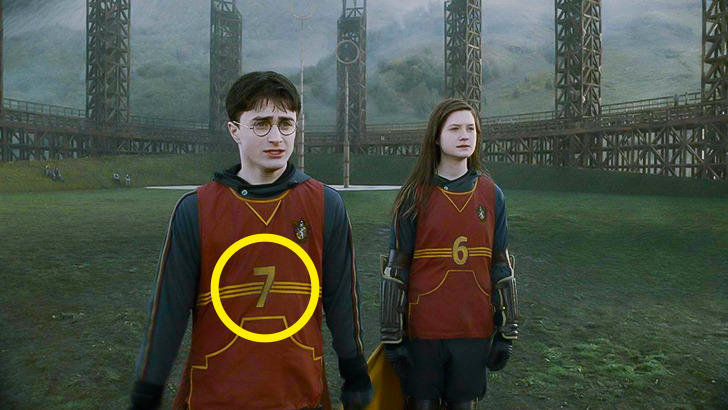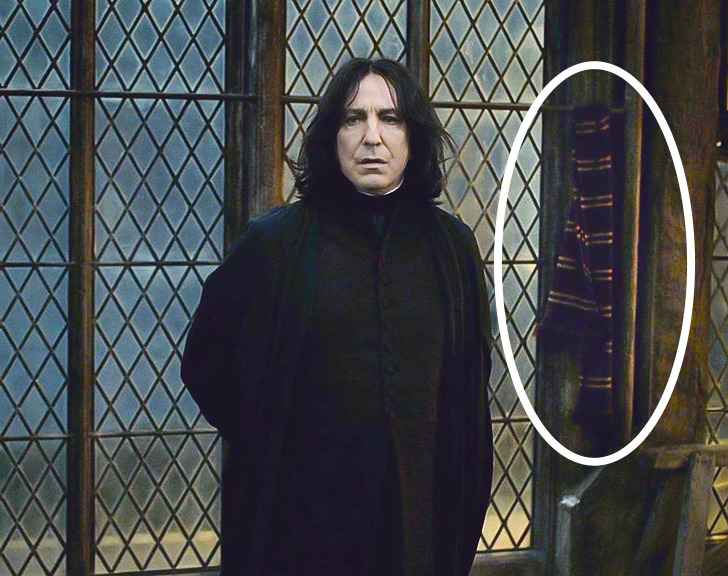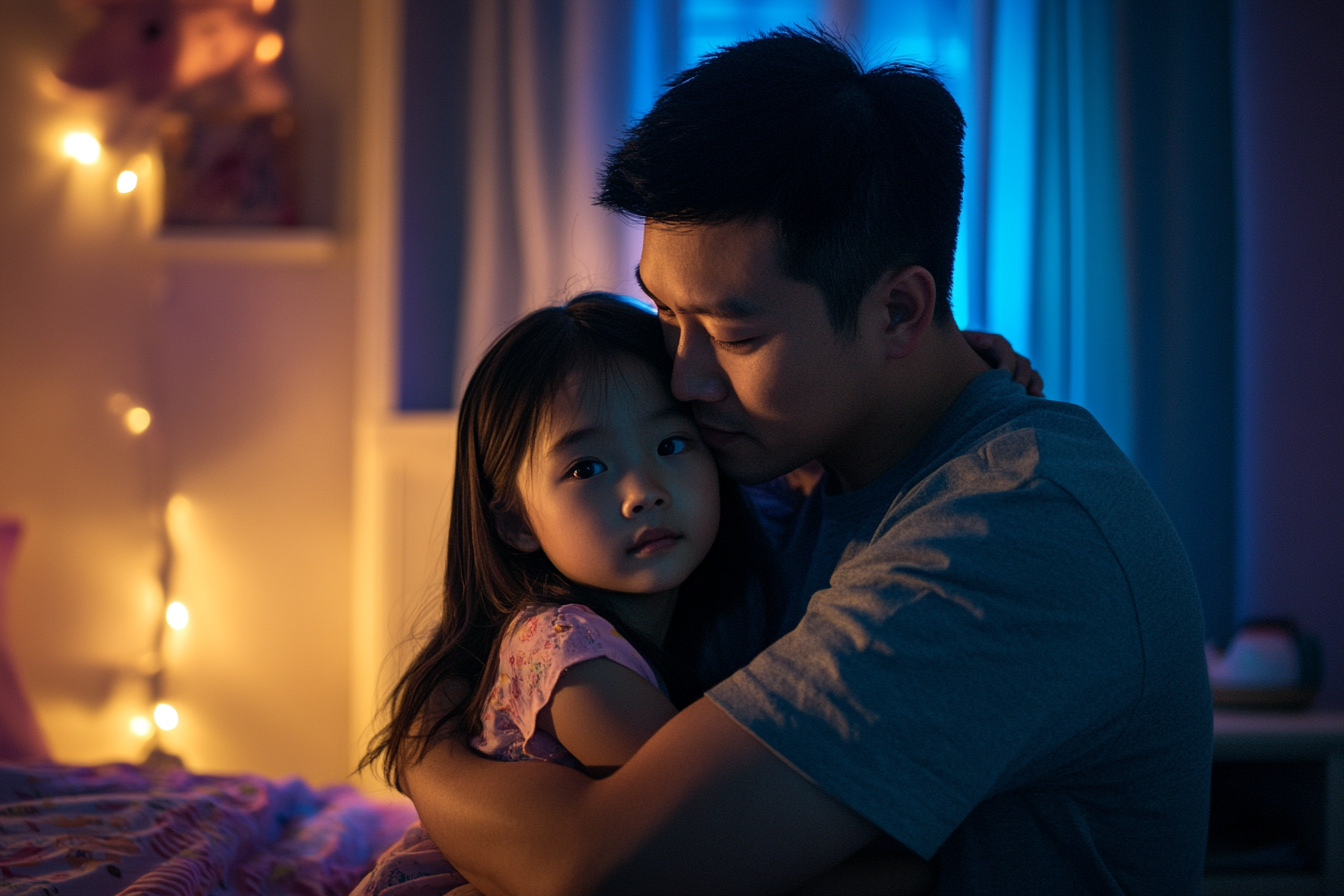The world of Harry Potter is one of the most beloved franchises across several generations. The seven books covering the captivating story of young wizards, in total, sold more than 450 million copies, and the movies grossed more than $7 billion. A part of such great success has been the detailed work of all people involved which we, as fans, can admire infinitely.
We at Now I’ve Seen Everything wanted to dive deep into this magical universe and brought you our curious finds.
1. One might think that Aunt Petunia is cooking in this scene. But she is actually dyeing Dudley’s old clothes grey for Harry’s uniform. This is only ever mentioned in the first book.

2. Number 7 on Harry’s Quidditch uniform

- Actually, the number 7 is a symbolic number in the world of JK Rowling. Moreover, Lord Voldemort has 7 Horcruxes and the last one, as we know, was Harry, which is quite symbolic too. However, the costume designer noted that the choice of this number for the Quidditch uniform is a reference to David Beckham, who played under this number a while back.
3. In the third movie, when Hermione appeared in class out of nowhere, we can actually see her time turner around her neck, which she hides in the next shot.

4. The scarves of Hermione, Ron, and Harry

- The costume designers decided to hint at the character of each person with the help of tiny detail — a scarf. If you’re paying attention, you know that each character ties it in their own way. Hermione tightens it as neatly as possible, according to the rules. Harry throws the end of the scarf over his shoulder. Ron doesn’t tie this accessory at all.
5. Although it may have gone unnoticed amidst all the chaos, in Harry Potter and the Deathly Hallows: Part 1 we get to see a reunion between Hermione and Viktor Krum.

6. As the story progresses and Harry and his friends begin to destroy the Horcruxes, you can see how Voldemort’s clothes become discolored, his eyes droop, and small lesions appear on his skin as a sign that he is getting weaker.

7. The changing costumes of Dolores Umbridge

- In the image of Dolores, it was important to outline that she has power. We see that she, like many other powerful people, is rather conservative. For example, she wears the same hairdo and sticks to the same colors. Umbridge adores the color pink but its hues change as the plot develops.
- The costume designer commented on it in the following way, “I started with a lighter pink, and then as the film developed the pinks get hotter and hotter and hotter because she’s getting more and more hysterical.”
8. Harry’s scar

In the final shot of the film, Harry’s scar is noticeably faded and barely visible. It’s the reference to the last line of the novel series, “The scar had not pained Harry for 19 years. All was well.”
9. Ralph Fiennes (Lord Voldemort) asked for a hook to be added to Voldemort’s wand so that he could move more fluidly and “snake-like” without the wand falling from his hand.

10. In the last movie, Lucius Malfoy is seen sporting a new tattoo on his neck. This is the prisoner number he was given when he entered Azkaban.

11. Gilderoy Lockhart’s wig

- In Harry Potter and the Chamber of Secrets, attentive viewers can notice that the professor of Defence against the Dark Arts, has a wig lying on his table. As we will later learn, Lockhart is a liar, who was cheating everyone and hadn’t done any feats. That is, he lies about everything and even his golden curls are fake.
12. Professor McGonagall has a secret talent.

- The Quidditch trophy from Harry Potter and the Sorcerers’ Stone not only features James Potter, Harry’s father but Professor McGonagall as well. Who would have guessed she was such a great player.
13. Hermione’s valuables.

- When Lockhart unleashes the pixies, Hermione immediately throws her books to the ground while no one else does because she knows the pixies will rip anything in plain sight apart.
14. Severus Snape and Gryffindor’s scarf

- Severus Snape is one of the most controversial characters. It’s not without reason that we see a striped scarf from Gryffindor hanging on the wall in the scene where he is killed. Perhaps he personifies the true inclination of Severus, and in due time he should have gone to Gryffindor, not to Slytherin.
- In the book, Dumbledore once says the following phrase relating to the distribution of students by faculty, “Sometimes I believe we sort too soon.” Perhaps, the professor was right. Perhaps, the scarf hanging in the closet is saying that people can change for the better.
15. As strange as it may seem, in Harry Potter and the Prisoner of Azkaban, a portrait of Voldemort can be seen on the side of the staircase.

What details in Harry Potter did you manage to notice only after re-watching or re-reading each one?
Preview photo credit Harry Potter and the Chamber of Secrets / Warner Bros. Pictures, Harry Potter and the Deathly Hallows: Part 1 / Warner Bros. Pictures
A filha de 7 anos do meu noivo prepara o café da manhã e faz todas as tarefas todos os dias — fiquei surpreso quando descobri o porquê

No começo, achei cativante que minha futura enteada acordasse antes do amanhecer para preparar cafés da manhã elaborados e limpar a casa. Mas tudo mudou quando descobri a razão de partir o coração por trás da obsessão dessa menina de sete anos em ser a dona de casa perfeita.
No começo, percebi gradualmente. Minha futura enteada, Amila, descia as escadas antes do amanhecer, seus pezinhos fazendo batidas suaves no carpete.

Uma menina andando descalça sobre um tapete | Fonte: Midjourney
Ela tinha apenas sete anos, mas lá estava ela todas as manhãs, determinada a misturar massa de panqueca ou ovos mexidos.
Eu achei fofo no começo. A maioria das crianças da idade dela ainda estava mergulhada em sonhos com unicórnios ou qualquer coisa que os alunos do segundo ano sonhassem hoje em dia, enquanto ela era uma garota-propaganda de uma boa criança.
Mas quando percebi que essa era apenas a rotina dela, comecei a me preocupar.

Uma mulher preocupada | Fonte: Midjourney
A primeira vez que a vi medindo cuidadosamente o pó de café no filtro, meu coração quase parou.
Quatro pés e nada em seu pijama arco-íris, cabelo escuro bem preso em rabos de cavalo, manuseando utensílios quentes de cozinha antes do nascer do sol. Não estava certo.
“Você acordou cedo de novo, querida”, eu disse, observando-a encher xícaras com café quente.

Uma garota fazendo café | Fonte: Midjourney
O balcão da cozinha brilhava, e o cheiro de café fresco enchia o ar. “Você limpou aqui?”
Ela sorriu para mim, seu sorriso banguela era tão ansioso que fez meu coração doer.
“Eu queria que tudo estivesse bem quando você e o papai acordassem. Vocês gostam do café? Eu descobri como usar a máquina!”
O orgulho em sua voz me pareceu estranho.

Uma garota orgulhosa | Fonte: Midjourney
Embora a maioria das crianças goste de aprender a fazer tarefas “de adulto”, havia algo em seu tom que parecia indicar que ela estava ansiosa demais para agradar.
Olhei ao redor da cozinha. Tudo estava impecável, e Amila tinha o café da manhã disposto como uma revista.
Há quanto tempo ela estava acordada? Quantas manhãs ela passou aperfeiçoando essa rotina enquanto dormíamos?

Uma mulher preocupada em uma cozinha | Fonte: Midjourney
“Isso é muito atencioso da sua parte, mas você realmente não precisa fazer tudo isso”, eu disse, ajudando-a a descer do banco. “Por que você não dorme até mais tarde amanhã? Eu posso fazer o café da manhã.”
Ela balançou a cabeça vigorosamente, as tranças escuras balançando. “Eu gosto de fazer isso. Sério!”
O desespero na voz dela disparou alarmes na minha cabeça. Nenhuma criança deveria soar tão ansiosa sobre pular tarefas.

Uma mulher carrancuda | Fonte: Midjourney
Ryan entrou então, espreguiçando-se e bocejando. “Algo cheira incrível!” Ele bagunçou o cabelo de Amila ao passar, pegando uma caneca de café. “Obrigado, princesa. Você está se tornando uma dona de casa e tanto.”
Lancei-lhe um olhar, mas ele estava ocupado demais examinando o telefone para notar. A palavra “dona de casa” pesava no meu peito, como algo ligeiramente podre.
Observei o rosto de Amila se iluminar com o elogio, e meu desconforto ficou mais forte.

Uma garota orgulhosa | Fonte: Midjourney
Isso se tornou nossa rotina — Amila brincando de casinha enquanto dormíamos, eu observando com preocupação crescente, e Ryan aceitando tudo como se fosse a coisa mais natural do mundo.
Mas não havia nada de natural em uma criança tão motivada a completar tarefas, especialmente aquelas que ela mesma havia assumido. Não havia nada de fofo nas olheiras se formando sob seus olhos, ou na maneira como ela se encolhia quando deixava algo cair, como se esperasse punição pela imperfeição.
Certa manhã, enquanto limpávamos a bagunça depois do café da manhã (eu insisti em ajudar, apesar dos protestos dela), decidi investigar mais a fundo.

Uma mulher limpando uma cozinha | Fonte: Midjourney
A questão estava me atormentando há semanas e eu não podia mais ignorá-la.
“Querida”, eu disse, ajoelhando-me ao lado dela enquanto ela limpava a mesa, “você não precisa acordar tão cedo para fazer tudo isso. Você é só uma criança! Nós é que deveríamos estar cuidando de você, não o contrário.”
Ela continuou esfregando um ponto invisível, seus pequenos ombros tensos. “Só quero ter certeza de que está tudo perfeito.”
Algo em sua voz me fez parar.

Uma menina limpando uma cozinha | Fonte: Midjourney
Eu gentilmente peguei o pano de suas mãos, notando como seus dedos tremiam levemente. “Amila, querida, me diga a verdade. Por que você está trabalhando tanto? Você está tentando nos impressionar?”
Ela não me olhava nos olhos, mexendo na bainha da blusa. O silêncio se estendeu entre nós, pesado com palavras não ditas.
Finalmente, ela sussurrou: “Ouvi papai falando com o tio Jack sobre minha mãe. Ele disse que se uma mulher não acordar cedo, cozinhar e fazer todas as tarefas, ninguém jamais a amará ou se casará com ela.”

Uma garota ansiosa | Fonte: Midjourney
Seu lábio inferior tremeu. “Tenho medo… se eu não fizer essas coisas, papai não vai mais me amar.”
As palavras me atingiram como um golpe físico. Olhei para essa criança preciosa, observando-a carregar o peso de tais expectativas tóxicas, e senti algo dentro de mim estalar.
Anos de progresso nos direitos das mulheres, e aqui estava meu noivo supostamente progressista, perpetuando casualmente o mesmo lixo medieval que havia impedido as mulheres de progredirem por gerações.
“Isso não está acontecendo”, murmurei. “Não na minha casa.”

Uma mulher determinada | Fonte: Midjourney
A Operação Wake-Up Call começou na manhã seguinte. Enquanto Ryan terminava seu café da manhã (feito por sua filha de sete anos, é claro), eu alegremente tirei o cortador de grama da garagem.
“Você poderia cortar a grama hoje?”, perguntei ao entrar na cozinha. “Ah, e não esqueça de aparar os cantos.”
Ele deu de ombros, concordando bastante. “Claro, sem problemas.”
No dia seguinte, empilhei roupa limpa na mesa.

Uma mulher colocando roupa para lavar em uma mesa | Fonte: Midjourney
O cheiro limpo de amaciante de roupas enchia o ar. “Ei, você consegue dobrar isso direitinho? E já que está nisso, que tal lavar as janelas?”
“Tudo bem…” Ele me lançou um olhar curioso. “Mais alguma coisa?”
No terceiro dia, quando pedi para ele limpar as calhas e reorganizar a garagem, a desconfiança já estava clara. Eu podia ver isso na forma como ele franzia a testa e na leve hesitação antes de cada tarefa.

Um homem carrancudo | Fonte: Midjourney
“O que está acontecendo?” ele perguntou, franzindo a testa. “Você me fez fazer mais tarefas do que o normal.”
Sorri docemente, canalizando toda a minha frustração para um falso brilho. “Ah, nada. Só estou me certificando de que você continue útil para mim. Afinal, se você não está fazendo sua parte, não vejo por que me casaria com você.”
As palavras caíram exatamente como pretendido. Ryan olhou para mim, boquiaberto. “O quê? Do que você está falando?”

Um homem chocado | Fonte: Midjourney
Respirei fundo, endireitando os ombros. O momento pareceu crucial — como se tudo em nosso relacionamento dependesse do que viria a seguir.
“Ryan, sua filha acorda toda manhã para fazer café da manhã e limpar a casa. Ela tem sete anos. SETE. Você sabe por quê?”
Ele balançou a cabeça e deu de ombros.
“Porque ela ouviu você dizer ao Jack que a mãe dela não valia a pena ser amada, a menos que ela acordasse cedo para cozinhar e fazer tarefas”, respondi.

Uma mulher falando com um homem | Fonte: Midjourney
“É nisso que ela acredita agora: que seu amor por ela depende do quanto ela faz por você.”
“Eu não… quero dizer, eu não quis dizer isso…” ele gaguejou, mas eu o interrompi.
“A intenção não importa. Você tem ideia do tipo de pressão que isso coloca nela? Ela é uma criança, Ryan, não uma empregada ou uma parceira. E caso você não tenha notado, não estamos mais em 1950. Ela merece saber que seu amor é incondicional, e você lhe deve um pedido de desculpas.”
O silêncio que se seguiu foi ensurdecedor.

Um homem pensativo | Fonte: Midjourney
Eu vi a realização passar pelo seu rosto, seguida por vergonha e então determinação. Era como ver gelo derreter.
Naquela noite, fiquei no corredor enquanto Ryan batia na porta de Amila. Meu coração martelava contra minhas costelas enquanto eu ouvia, esperando não ter pressionado demais, rezando para que isso ajudasse em vez de machucar.
“Amila, querida, preciso falar com você”, ele disse suavemente.

Um homem falando com sua filha | Fonte: Midjourney
“Você me ouviu dizer algo sobre sua mãe que eu nunca deveria ter dito, e isso fez você pensar que tem que se esforçar muito para me fazer te amar. Mas isso não é verdade. Eu te amo porque você é minha filha, não pelo que você faz.”
“Sério?” Sua voz era baixa, esperançosa. “Mesmo que eu não faça o café da manhã?”
“Mesmo que você nunca mais faça café da manhã.” A voz de Ryan falhou. “Você não precisa provar nada para mim ou para qualquer outra pessoa para ser amada. Você é perfeita do jeito que é.”

Um homem abraçando sua filha | Fonte: Midjourney
Pressionei uma mão na boca, segurando as lágrimas enquanto eles se abraçavam, o pequeno corpo de Amila desaparecendo no abraço do pai. O som de suas fungadas silenciosas se misturava ao zumbido da casa se acomodando ao nosso redor.
As semanas que se seguiram trouxeram mudanças sutis, mas significativas. Ryan começou a assumir mais responsabilidades domésticas sem ser solicitado. Mais importante, ele se tornou consciente de suas palavras, cuidadoso para não perpetuar as ideias prejudiciais que ele havia plantado inconscientemente na mente de Amila.
Às vezes eu o pegava observando-a tocar, com uma mistura de culpa e amor no rosto, como se a estivesse vendo pela primeira vez.

Uma menina brincando enquanto seu pai assiste | Fonte: Midjourney
O amor não era apenas sobre sentimentos calorosos e confusos ou momentos perfeitos, percebi. Às vezes, era sobre ter conversas difíceis e responsabilizar um ao outro.
Tratava-se de quebrar ciclos e construir algo melhor a partir dos pedaços.
Enquanto nos sentávamos para tomar café da manhã juntos, ninguém tendo sacrificado o sono ou a infância para ganhar um lugar à mesa, olhei para minha pequena família com silenciosa satisfação.

Um homem e sua filha jantando | Fonte: Midjourney
Bobagem medieval? Não na minha casa.
Aqui vai outra história: Quando criança, minha mãe tinha uma regra inquebrável: nunca toque no armário dela. Eu nunca entendi o porquê, e ela nunca explicou. Depois que ela faleceu, eu voltei para casa para arrumar as coisas dela. Eu finalmente abri o armário proibido, mas o que eu encontrei lá me deixou questionando tudo o que eu achava que sabia. Clique aqui para continuar lendo.
Este trabalho é inspirado em eventos e pessoas reais, mas foi ficcionalizado para fins criativos. Nomes, personagens e detalhes foram alterados para proteger a privacidade e melhorar a narrativa. Qualquer semelhança com pessoas reais, vivas ou mortas, ou eventos reais é mera coincidência e não intencional do autor.
O autor e a editora não fazem nenhuma reivindicação quanto à precisão dos eventos ou à representação dos personagens e não são responsáveis por nenhuma interpretação errônea. Esta história é fornecida “como está”, e quaisquer opiniões expressas são as dos personagens e não refletem as opiniões do autor ou da editora.



Leave a Reply